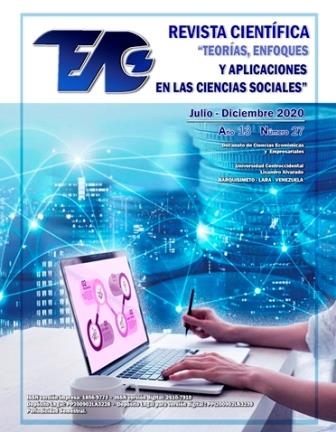Analysis of the evolution of exports from the tuna sector to the European Union and their impact on the trade balance of Ecuador, period 2014 - 2018
Keywords:
export, tuna, international trade, trade balance, european unionAbstract
The purpose of this study is to analyze the evolution of the exports of the tuna sector to the European Union and its impact on the trade balance within a time frame between 2014 - 2018. Its investigative approach to obtaining the data it is qualitative-quantitative. It is structured based on a theoretical-conceptual and legal framework. The deductive, inductive methodologies allowed to expand the knowledge and its impact regarding the trade agreement with the European Union to measure its export strength of loin and canned Ecuadorian tuna. An analysis of prospective reflection is also proposed, considering possible scenarios, alternative solutions and improvements under traceability and differentiation criteria for the future of the sector. Among the main results obtained, it is determined that the tuna sector is vital for the economy, contributing 5% to GDP. In terms of trade balance, there is no evidence of a significant rebound in the increase in exports from the beginning of the trade agreement. Although there is evidence of a decrease at the level of imports of the oil segment, especially in 2014, which causes a noticeable effect on the Trade Balance. On the other hand, non-oil exports have been recovering until achieving an upward trend. This shows that non-oil exports, including tuna, are a key factor towards economic sustainability, which, while still highly dependent on oil revenues, has been weakening more strongly in the last five years.
Downloads
References
BCE. (2019). FICHAS DEL ATÚN DEL ECUADOR - PROECUADOR. Obtenido de http://ceipa.com.ec/wpceipa/wp-content/uploads/2019/09/AT%C3%9AN-EN-CONSERVAS-AGO-19_-ok-web.pdf
Cámara de Comercio de Guayaquil. (2019). Entorno Económico Ecuador. Obtenido de http://www.lacamara.org/website/wp-content/uploads/2018/02/Entorno-economico-ccg.pdf
Diario El Telegrafo. (21 de 06 de 2019). El atún representa el 5% del PIB del Ecuador. Obtenido de https://www.eltelegrafo.com.ec/noticias/economia/4/atun-producto-interno-bruto-ecuador
El Universo. (13 de 08 de 2019). Ministro Iván Ontaneda presentó nueva Ley orgánica de Pesca y Acuicultura. Obtenido de https://www.eluniverso.com/noticias/2019/08/16/nota/7473546/ontaneda-presenta-nueva-ley-organica-pesca-acuicultura
Fuss, M., & McFadden, D. (2014). Production Economics: A Dual Approach to Theory and Applications: Applications of the Theory of Production.North-Holland.
Hernández, R., Fernández, C., & Baptista, P. (2014). Metodología de la Investigación. México DF: McGRAW-HILL.
Ministerio de Producción Comercio Exterior Inversiones y Pesca. (15 de 08 de 2019). 45 AÑOS DESPUÉS SE PRESENTA EL PRIMER PROYECTO DE LEY DE PESCA Y ACUICULTURA EN ECUADOR. Obtenido de http://www.produccion.gob.ec/45-anos-despues-se-presenta-el-primer-proyecto-de-ley-de-pesca-y-acuicultura-en-ecuador/
Ricardo, D. (1817). Principios de Economía Política y Tributación. Claridad.
Smith, A. (1794). Investigacion de la naturaleza y causas de la riqueza de las naciones, Volumen1. Investigacion de la naturaleza y causas de la riqueza de las naciones, Volumen1.
Toro, J. (2012). Fundamentos de Teoría Económica: Conceptos Prácticos de Micro y Macroeconomía.
Vargas, G. (2006). Introducción a la Teoría Económica Un Enfoque Latinoamericano. Pearson Education.
Published
How to Cite
Issue
Section
Derechos del/de autor/es a partir del año de publicación
Esta obra está bajo la licencia:
Creative Commons Reconocimiento-NoComercial-CompartirIgual 4.0 Internacional (CC BY-NC-SA 4.0)
Las opiniones expresadas por los autores no necesariamente reflejan la postura del editor de la publicación ni de la UCLA. Se autoriza la reproducción total o parcial de los textos aquí publicados, siempre y cuando se cite la fuente completa y la dirección electrónica de esta revista. Los autores(as) tienen el derecho de utilizar sus artículos para cualquier propósito siempre y cuando se realice sin fines de lucro. Los autores(as) pueden publicar en internet o cualquier otro medio la versión final aprobada de su trabajo, luego que esta ha sido publicada en esta revista.



